How to Scale Your Facebook Ads

Running Facebook ad campaigns is an effective way to grow your business. But while it’s easy to start advertising on social media, scaling Facebook ads brings its own set of questions.
If you spend between $20 and $100 daily on different types of Facebook ad campaigns and see a promising return on ad spend (ROAS), the next step is to increase your budget effectively and scale your ads.
Scaling Facebook advertising means increasing spending while maintaining a positive return—a challenge for any business, no matter the size of your budget.
To help you successfully transition from a $50 daily ad spend to $500 and beyond, we’ve put together six ways to scale Facebook ads, including choosing new audiences and increasing your existing campaigns’ conversion.
6 Key Ways to Scale Facebook Ads
- Choose new lookalike audiences
- Expand location targeting for your ad campaigns
- Increase your Facebook ad campaign budget (the right way)
- Duplicate successful ads
- Build a sales funnel
- Create new ads to get more from your campaign budget
It’s easy to bounce back from a bad day when your daily Facebook ad spend is only a few bucks. Staying positive when your ads aren’t converting and you’ve spent hundreds or thousands of dollars? That’s a little harder. Avoid scaling stress by trying these tips.
1. Choose new lookalike audiences
The first step to scaling your Facebook campaigns is to reconsider the size of your target audience.
Selecting a broader audience will give your Facebook pixel (now called the Meta pixel) more opportunities to find additional customers.
Lookalike audiences are one of two simple ways to find new customers using Facebook ads. The tool lives in the Facebook ads manager in your ad account.
Most advertisers begin by targeting a 1% lookalike audience: the people most similar to your list of current customers. Scale your ads by expanding that range to 3% to 5%. Increasing your lookalike audience lets you deploy more ads without exhausting your audience.
Failing to expand your audience while spending extra budget may cause audience fatigue: a slowdown in ad performance that occurs when most of your audience has already seen your ad.
Signs that you may have reached audience fatigue include:
- High-frequency rates (the number of times an individual has seen your ad)
- Increased cost per thousand (CPM)
- A general drop in performance
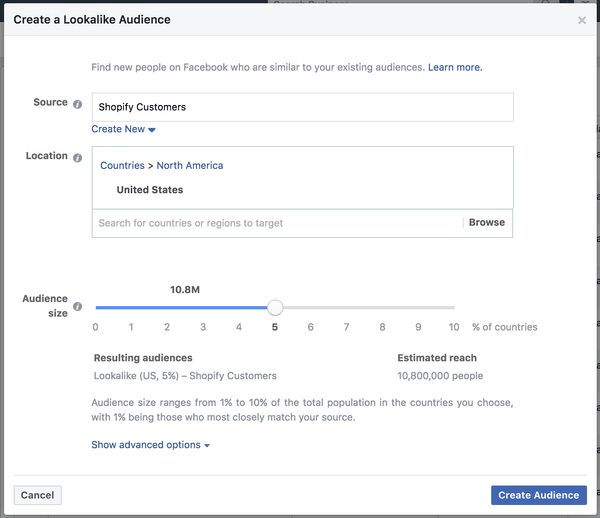
The Lookalike Audience creation tool is found under Audiences in the Facebook Ad Manager.
Depending on your location, a 3% to 5% lookalike audience can consist of 5 million to 10 million people. Together with the data from your Meta pixel, this gives the Facebook algorithm a good opportunity to find new likely customers.
Leveraging the insights gained from the pixel helps eliminate some of the risks that advertisers with very little data face when targeting larger audiences.
2. Expand location targeting for your ad campaigns
The second simple way to expand your audience efficiently is to find secondary markets.
If you sell lightweight goods, drop ship your product, or otherwise have an international product and distribution system, targeting a global audience is an easy way to scale.
The United States has one of the largest populations of online shoppers, but there’s also a lot of competition to reach them. Your ads may perform better in other countries with large English-speaking populations, such as Canada, Europe, and South America.
To scale your Facebook campaigns internationally, think creatively about whom to target. You may know your home demographics better than anyone, but don’t be afraid to test ads on global audiences you haven’t considered before. Spend some time in your ad account, looking for patterns to explore further.
Create global lookalike audiences
Once your Meta Pixel has collected enough data on your customer profile in one country, it can apply that information to find more customers abroad.
Creating a 1% lookalike audience that includes multiple countries outside the United States is a useful way to increase your reach and take advantage of the lower CPMs in less competitive regions. Pixel data is your best weapon for creating efficient, high-performing ad sets.
3. Increase your Facebook ad campaign budget (the right way)
Whether you’re setting a daily, weekly, or monthly spending limit, increasing your budget is the most essential step in scaling your Facebook ads.
You need to set and spend a budget to earn money on Facebook. While the idea of spending more on marketing without guaranteed returns can be scary, the trick is to increase your budget for winning ads.
By listening to Facebook’s guiding principles on setting your budget, you can spend your money more wisely.
Pay attention to the learning phase
Learning Phase is a term you might have seen in the Facebook Ad Manager.
It takes Facebook’s algorithm a specific amount of time and budget to decide to whom it should show your ad. When you launch a new ad set, Facebook starts a learning phase until it has delivered 50 optimization events.
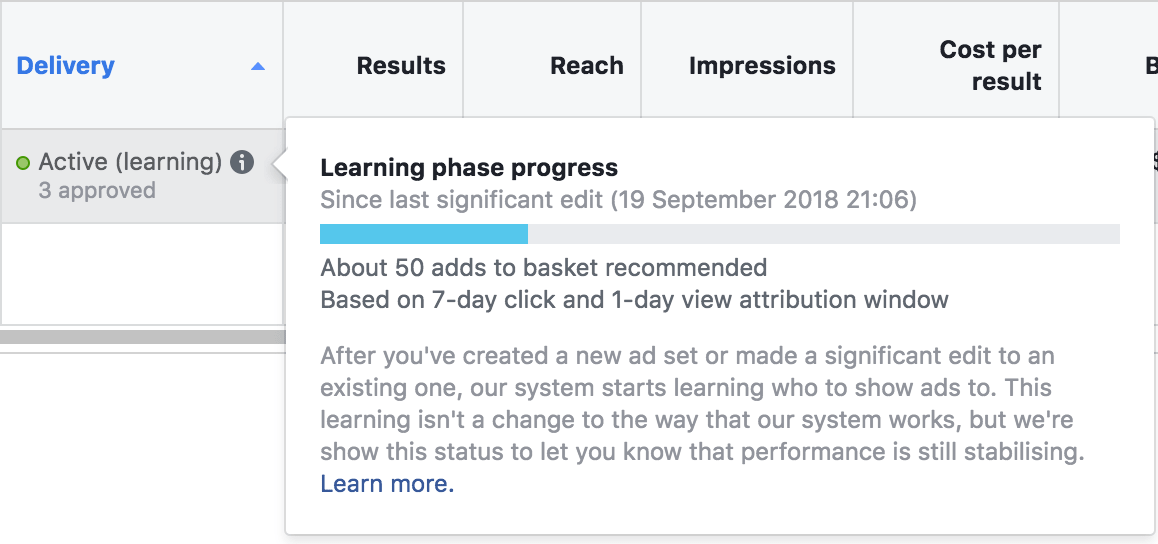
Scale Facebook ads by watching your learning phase.
Use the learning phase to give every campaign the best chance of success. Do this by providing the Facebook algorithm with a sufficient budget for learning. The general rule of thumb is to multiply your average cost per purchase (CPP) by 50, then divide that number by the conversion window to get your daily budget.
If your CPP is $30 and your conversion window is seven days:
($30 x 50) / 7 = $214
Setting a budget of $214 should allow the ads to complete the learning phase and optimize according to Facebook’s guidelines.
Facebook says that you can expect inconsistent performance during the learning phase, with some good and some not-so-good days. Facebook also states the importance of not changing your campaign during this stage, as minor tweaks can reset it.
Facebook emphasizes the importance of patience during this time and avoids the urge to scale back. Of all Facebook ad costs, giving your ad sets enough budget and time to optimize is one of the most important.
Once you’ve run a few Facebook ad experiments and have a clear idea of who you want to target, you can increase your ad spend on your winning ads—that’s the power of the learning phase.
Create split tests to optimize your campaign budget
With the split testing feature, you can set a large upfront budget on a campaign level and let your audiences compete for that budget. The Facebook algorithm will quickly recognize which ad set performs the best and shift most of your budget toward it.
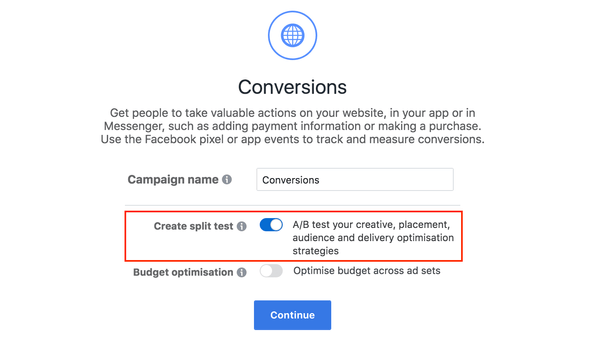
Split tests allow you to scale your daily budget without wasting money on a poorly performing audience.
4. Duplicate successful ads
Before changing your ad creative, consider scaling your Facebook Ads by manually duplicating your most successful ad sets and serving them to non-overlapping audiences. By doing this, you can create additional sets with a higher budget, increasing the chances of success.
Facebook Ad Manager doesn’t automatically suggest opportunities for duplicating ads. But it’s easy to create your own duplication rule by setting notifications for when an ad reaches a certain level of impressions, purchases, or other KPIs.
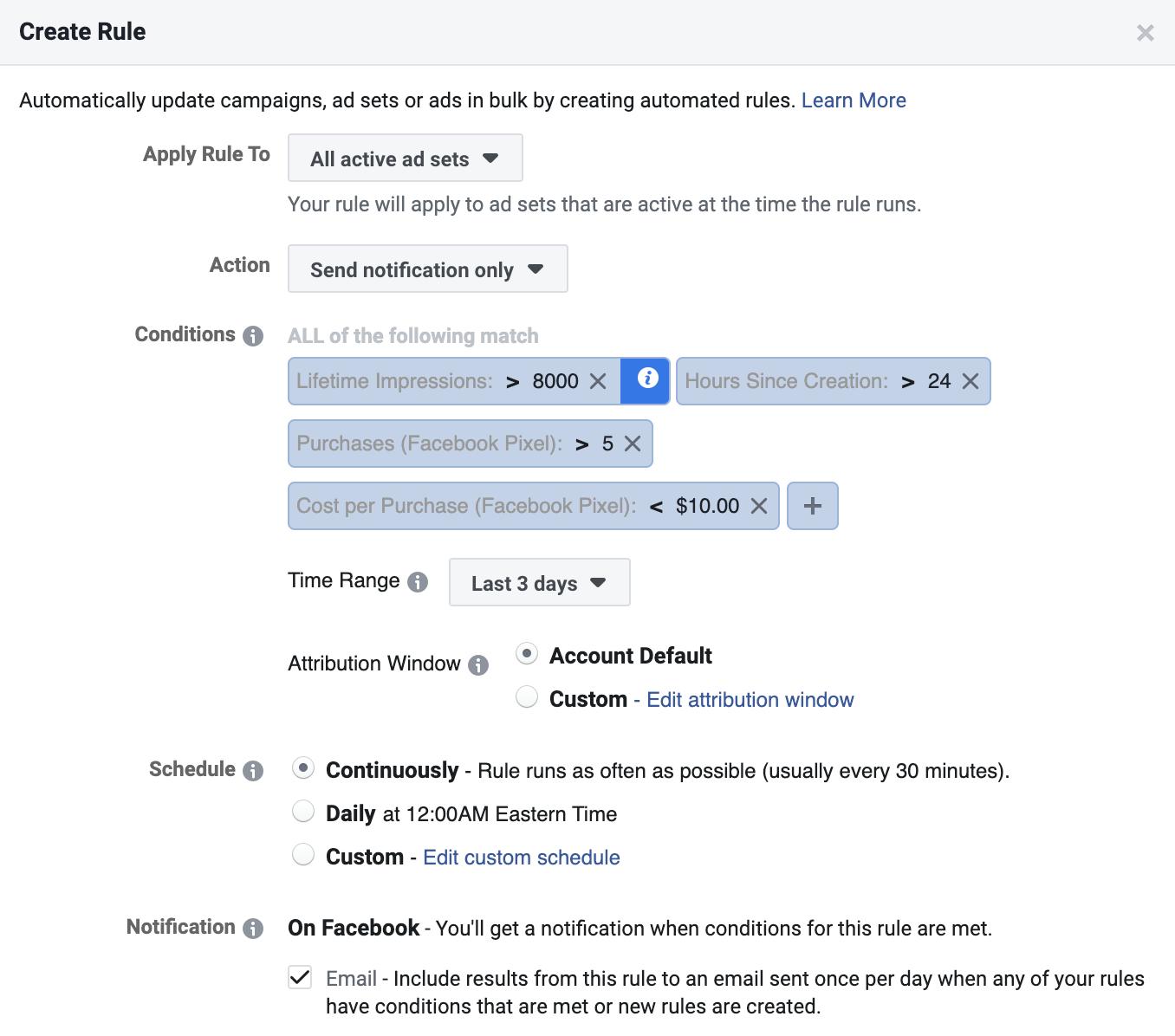
And maybe unsuccessful ads, too
Ads can underperform due to inaccurate targeting or simply bad timing. Sometimes, duplicating an underperforming ad can give it another chance to succeed.
There’s no automated rule for duplicating low-performing ads, so you’ll also need to set up your own notification rule to alert you to duplication opportunities.
5. Build a sales funnel
Alongside finding new audiences to target, consider investing more dollars into improving your conversion rates. One way to do this is to build a segmented Facebook funnel.
Most beginners set up their first Facebook ad campaigns to directly generate new sales. As you move from $50 to $500 a day in ad spend and begin scaling Facebook ads, you may want to build more layers into your customer journey.
Place Facebook ad campaigns higher up the funnel.
Try expanding your Facebook advertising funnel by building a warm audience that consists of people interested in your brand or products. While they haven’t yet made a purchase, they may have watched one of your videos or visited your website.
Retargeting Facebook ads at people who’ve previously visited your website can significantly improve your ad campaign performance. Retargeting a warm audience tends to produce a greater ROAS than cold audiences because they are already familiar with your brand or product.
Another benefit to targeting warm audiences is that, in terms of Facebook ad costs, it is less expensive to bid on higher funnel objectives, including:
- Video views
- Clicks
- Content views
- Add to cart
- Initiate checkout
Taking a portion of your advertising budget and focusing on these higher-funnel objectives will build a larger, warm audience that you can retarget for purchases.
Segment your warm audience
Your warm audience will grow as you scale your Facebook ads to reach more people. If you have a blanket retargeting audience serving Facebook ads to anyone who has visited your website in the past 30 days, you may want to break it up.
Break down this large group of potential customers to find which segments drive the highest return rather than indiscriminately increasing your budget on warm traffic.
A good way to segment your warm audience is by creating ad sets for the following:
- Video viewers (25%, 50%, or 75%)
- Page clickers (30, 60, or 180 days)
- Website visitors (30, 60, or 180 days)
- Viewed content (7, 30, or 60 days)
- Add to cart (7, 30, or 60 days)
To determine which audience performs best when retargeted, put individual budgets against each segment. Once you find the top performers, you can shift more of your campaign budget toward these segments or start running ads for that objective in a separate campaign.
If you don’t segment your retargeting audiences, your entire campaign budget could go to a lower-performing group. Don’t spend money targeting website visitors when your cart abandoners drive the best return on ad spend. Getting into the habit of targeting warm audiences is one of the most effective ways to scale your Facebook ads.
6. Create new ads to get more from your campaign budget
Don’t forget about the ad creative when scaling Facebook ads and your target audience. Ad fatigue is real, and without a plan in place, your ads can begin to feel stale—especially if you repeatedly focus on the same audience.
When ad fatigue occurs, introduce new types of Facebook ads so that as people move down your funnel, they don’t see the same images or videos over and over again. Keeping your creative fresh is critical even if you’re consistently reaching your target audience.
Create different ads for different parts of the funnel
Running multiple Facebook ad campaigns reduces fatigue, but customizing your message to customers at different stages of their journey can produce even higher click-through rates and ROAS.
Try a short Facebook video ad campaign introducing customers to your brand. Explainer videos like this by UNTUCKit can work well to prospect a cold audience. Placing a video early in the funnel allows you to build a warm audience of people who watched 25%, 50%, or 75% of the video, even if they didn’t click through to your website.
Once you’ve captured your video viewers, you can serve them new ads designed to target warm prospects. At this stage in your funnel, including customer testimonials to show social proof or answering frequently asked questions can help move your prospects closer to the purchasing phase.
 A retargeting carousel ad from UNTUCKit with a discount code and free shipping offer.
A retargeting carousel ad from UNTUCKit with a discount code and free shipping offer.
When serving creative to shoppers at the bottom of your funnel, such as website visitors or cart abandoners, try including a coupon code or highlighting a free shipping threshold. By changing your copy at this stage, you can provide new value to engage your target audience and bring them back to your website to complete their purchase.
Another overlooked audience is your previous customers. Using catalog sales or dynamic product ads at this phase will only show your customers products they might be interested in buying during their next purchase.
If you sell products that can be re-ordered (such as consumables) or are looking to launch a sub-brand, advertising these offerings to your existing customers can make a healthy contribution to your overall ROAS.
Customize creative for Facebook ad placements
Once you introduce new creative into your Facebook funnel, ensure it is optimized for multiple placements. Since you’re targeting customers at various stages in their buying journey, your ads will likely follow them from mobile devices to desktops and Instagram to Facebook.
If your creative only looks good in one of Facebook’s placements, you could miss out on reaching your prospective customers in other areas.
Facebook allows you to customize your creative for multiple placements, making your ad spend go further. Not having custom creative for multiple types of ad campaigns can make it much more challenging to scale Facebook ads.
Select all placements
When creating an ad campaign, you can choose “Select all placements that support asset customization” at the ad set level.
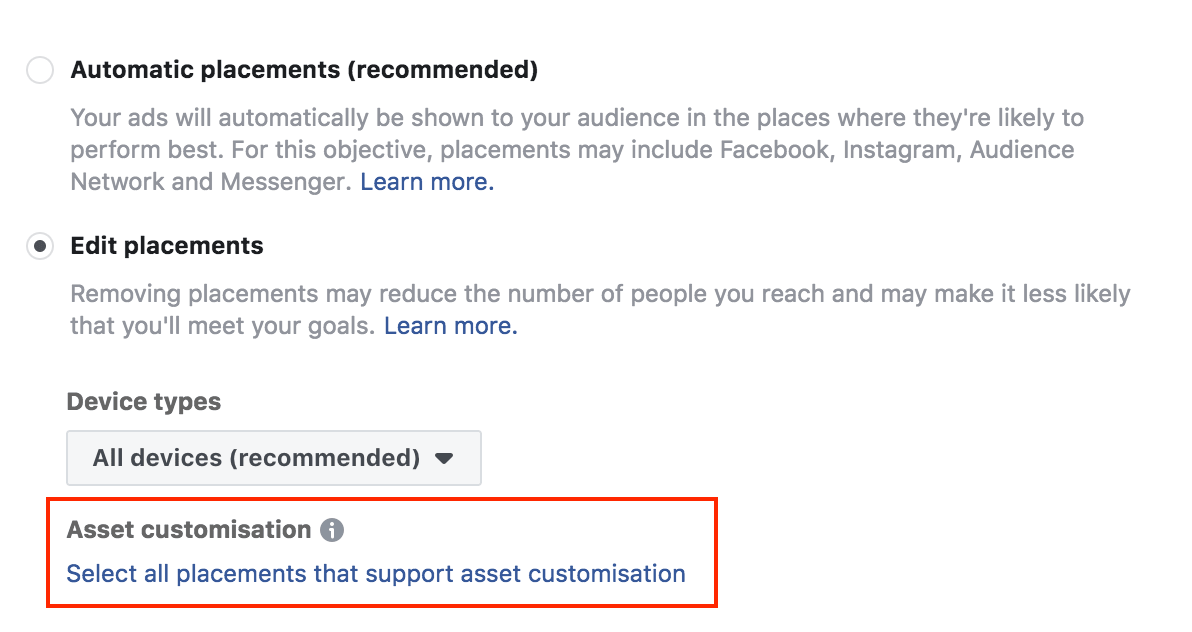
At the Ad Creation step, specify the Facebook page and Instagram account you want your ad to run from. Make sure to run your Instagram ad from an active Instagram account so that your ad appears even more native to the platform.
If you’re running a single image on Facebook that’s the standard 1:9 ratio and it’s performing well, you’ll also want to create a 1:1 version of that image for Instagram. At the ad set level, Facebook allows you to upload different versions of your image for different placements.
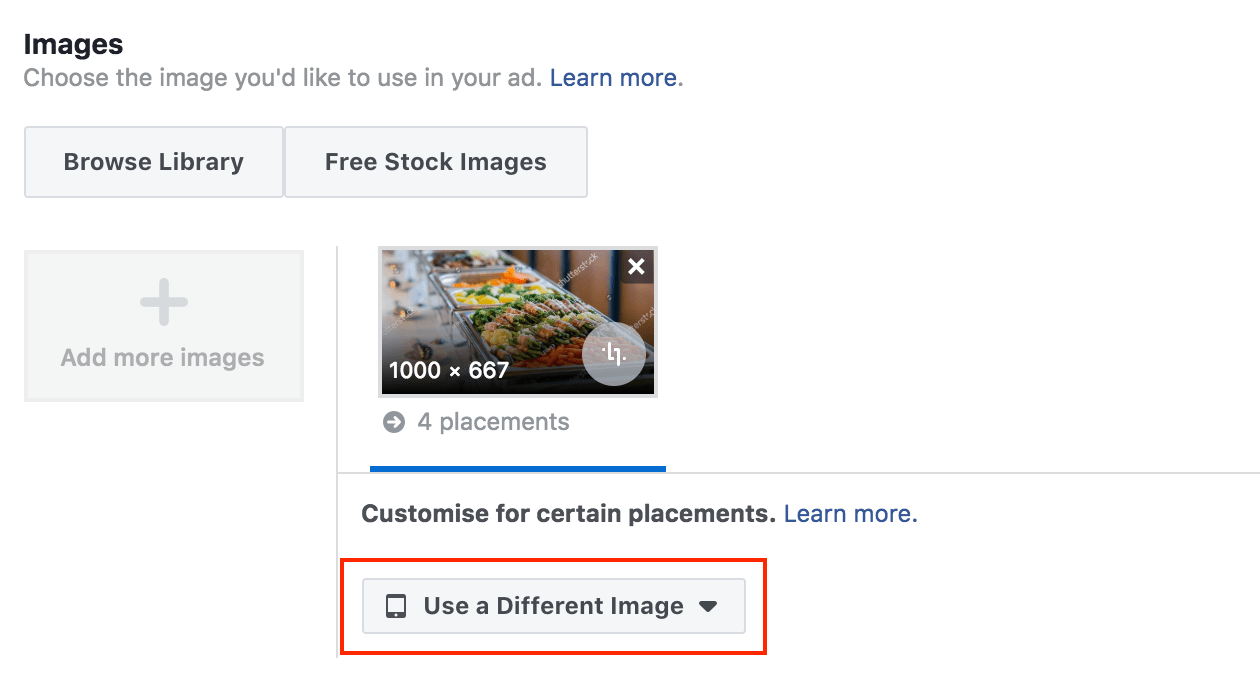
Videos
The same goes for video creative. Facebook now allows you to customize your video assets for multiple placements by uploading 1:1 versions for Instagram and even 15-second 9:16 versions for Instagram Stories.
By customizing your creative for all placements, Facebook will be able to show your ads to your target audience no matter what device or platform they use. This increases your opportunities for conversions and decreases your CPMs by allowing your ads to run in less competitive placements.
Have a strategy to scale your Facebook ads
There’s always a fair amount of risk when scaling any part of your business; the same goes for your Facebook ad campaigns.
Learning to scale Facebook campaigns takes time. The potential to increase your daily ad budget spend without seeing a positive return is always a scary thought, especially if you’ve never scaled paid ads before.
Scaling successful Facebook ad campaigns isn’t always easy. However, the increased sales and expanded audiences that strategic advertising campaigns can create means that increasing your advertising spend is often worth taking the plunge. The best way to mitigate these risks is by following a strategy like the one outlined in this post so that you can feel more confident about scaling your Facebook ads successfully.
Source: Shopify